Your Top 10 HVAC Questions Answered – Part 1
Have you met Kenny Hart?
Kenny Hart, also known as The Plumbing and HVAC Guy, lives in Virginia and has been an ASHI member since 1999. He’s worked in the plumbing and HVAC field for more than 41 years. If you don’t live in or even near Virginia, you still might know Kenny. He regularly presents training sessions about plumbing and HVAC issues to home inspectors in the United States and Canada. Since his first presentation at the ASHI Great Plains Chapter in 2002, he’s presented information at more than 75 national, regional and state home inspection events, including InspectionWorld.
Kenny hears many of the same questions at his training sessions. Because his presentations draw up to 100 people and because he has returned to many of the same chapters and locations over the years, he sometimes asks himself, “Why do inspectors keep asking me the same questions about the same HVAC issues? Am I not teaching this very well?” But the answer occurred to him once he began asking the people in the room about their experience in the profession. He said, “I realized that there is constant growth and change in the home inspection business. New home inspectors attend each training session. And everyone who is new to home inspection seems to have a common set of questions.”
Here, Kenny presents a list of those questions. The good news is, he provides the answers as well. Watch for a related article in the upcoming August issue of the ASHI Reporter. We’ll go “on the road with Kenny”
and hear stories of his ASHI (and his American) Road Show Experience.
Contact Kenny Hart at theplumbingandhvacguy@gmail.com or on Facebook at www.facebook.com/plumbingandhvacguy.
Kenny’s Top 10 HVAC Questions
- How can I be sure I’m looking at
a heat pump and not an air
conditioning condensing unit? - Can a fuel gas appliance connector pass through the cabinet wall to connect to the furnace gas control?
- Can you use copper for natural gas piping?
- How many elbows can you use on the vent pipe from a temperature pressure relief (TPR) valve?
- How is a proper sediment trap configured?
- How long should an HVAC system be energized before it is operated?
- How important is the trap on
the condensate drain? - Is that furnace direct-vent or not direct-vent?
- When did they start putting the evaporator in the furnace?
- What should be the clearance for condensing units and outdoor units?
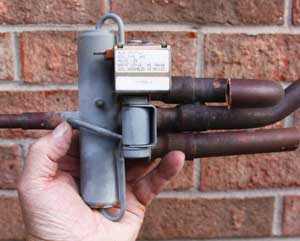
Differentiating a condensing unit (an air conditioner) from an outdoor unit (a heat pump) from a distance can be difficult. In fact, equipment manufacturers sometimes use the same cabinets for these two types of equipment. There is, however, one component you’ll find in a heat pump outdoor unit that you won’t find in a condensing unit: a reversing valve, also known as a four-way valve. This component directs the flow of refrigerant gas according to the mode setting of the thermostat. Because condensing units of air conditioning systems only operate in the cooling mode, condensing units do not have reversing valves.
I’ve held a license as a Master Gas Fitter since the early 1980s. I began installing gas furnaces many years before the Commonwealth of Virginia distinguished gas fitting as being separate from the plumbing and HVAC trade. Since that time, I’ve never extended the connector into the cabinet. Initially, this was because our code prohibited it, and as a tradesman, I felt it was the best practice to use a steel nipple to extend gas service through the metal panel.
This question generates a lot of comments from home inspectors and even from some in the plumbing and HVAC field. It might be confusing because the practice has changed over time or because local authorities have differing rules. But in many areas today, it is an acceptable practice to insert the connector into the cabinet if the connector is protected by a grommet where it passes into the furnace. Check with your local authority having jurisdiction (AHJ).
Provided that the natural gas has no more than 0.3 grains of hydrogen sulfide per 100 cubic feet, copper is approved for use by the International Residential Code and the Uniform Plumbing Code. In my area, copper is used extensively because we routinely install a gas distribution system known as a 2 psi system. With these systems, higher gas pressure is piped throughout the house and then the pressure is reduced with a special regulator at the appliance. This high-pressure delivery system allows for much smaller gas lines than what are used with a conventional gas distribution system. In fact, the gas line of choice by installers of the 2 psi system is 3/8-inch seamless, soft-rolled copper coil tubing.
In 2011, when researching the use of copper tube in natural gas work for an ASHI Reporter article I co-authored with Alan Carson, I learned that it was used not only in many states, but also in many other countries. However, despite few problems being associated with it, and even when installed according to a specific set of guidelines developed for copper, some localities do not allow copper to be used for natural gas work of any kind. Check with your local AHJ.
Temperature pressure relief (TPR) valves are more closely associated with plumbing, but because water heaters are sometimes used in heating systems, TPR valves are found on heating apparatuses as well. Many TPR valves have a simple blow-off tube installed. The tube directs any discharge from the device to the floor. However, some TPR valves are piped to a distant location so the flow of water or steam will not damage the immediate area. The number of elbows used to pipe the discharge line away from the heater is important, as each elbow creates resistance to the discharge flow. You’d be hard-pressed to find a specific number of elbows cited in a water heater installation manual, but if you look closely, you might see the limit printed on the TPR valve itself. I occasionally find the limit printed on the large yellow tag connected under the lever on top of the device [Photo 2].
The number I usually find stated is four 90° elbows. When more turns are needed, the installer should consider using longer turn fittings, increasing the size of the discharge pipe or discharging into an indirect waste receptacle.
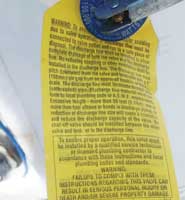
Photo 2: The number of elbows allowed in the discharge line of the TPR valve is sometimes printed on the tag hanging from the TPR valve itself. This Watts TPR valve states that having more than four elbows will create a restriction. [Image Kenny Hart]
A sediment trap is a gas piping configuration that should be installed as close as is practical to gas appliances such as water heaters, furnaces and boilers. Its purpose is to catch debris that sometimes moves along with the flow of gas. It uses a tee, a capped nipple and gravity to trap the debris before it gets blown into the equipment’s burner control valve. For a sediment trap to be effective, it has to be installed so that debris gets forced into the capped nipple or so debris flowing with the gas is diverted or stopped in a manner that allows it to fall into the capped nipple.
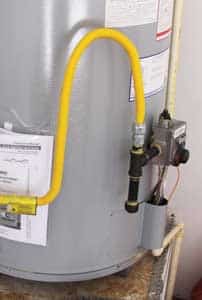
Photo 3: With the tee fitting positioned so the run of the tee is vertical and the appliance is connected at the branch, gas should enter through the top run. In many localities, this is the preferred configuration. [Image Kenny Hart]
With the tee fitting positioned so that the run of the tee is vertical and the appliance is connected at the branch, gas should enter through the top run [Photo 3]. With the force of the gas and gravity, debris will be forced down into the capped nipple and should move past the appliance connection. If the gas feed enters through the branch, the appliance should be connected at the top run. Here, the gas pressure should force the debris into the wall of the tee, and with the help of gravity, the debris will drop into the capped nipple [Photo 4].

Photo 4: If the gas feed enters through the branch, the appliance should be connected at the top run. [Image Kenny Hart]
Many home inspectors occasionally inspect vacant properties. It’s not uncommon to get to the property just as the utility company is pulling away. Inspectors often are asked to turn on systems and operate the equipment. Testing the condensing or outdoor unit without allowing some warm-up time can seriously damage the compressor. Many manufacturers state that the power should be on for 24 hours before operation, but some manufacturers note that eight hours should be sufficient.
The main concern with operating a system when it has been off for an extended time is that the compressor gets cold. The oil in a compressor actually attracts some refrigerants. R-22 systems are particularly susceptible to this problem. If the refrigerant moves or migrates to the compressor, it can mix with the oil. During a cold startup, the refrigerant can boil or flash off quickly and cause some of this mix of oil and liquid refrigerant to be pumped away from the compressor. Compressors need oil for lubrication and should never pump a liquid.
Some manufacturers use crankcase heaters to keep the compressor warm during the “off” time. This can help prevent refrigerant from migrating into the compressor. If the system has been off for an extended period of time, but is then re-energized for the recommended length of time, the crankcase heater also is energized during that time. The compressor will warm slowly and the heat will push any refrigerant out of the compressor before the startup can damage it.
The main purpose of a condensate trap is to prevent air from moving in or out of the drain connections of the condensate tray. Traps must be installed in a manner that will stop the air from passing through the drain openings, but allow the condensate water to flow from the condensate tray when the system is running.
If the evaporator/indoor coil and condensate trays are downstream of the blower (which is what happens when either coil is combined with a forced hot air furnace), they will be under positive pressure. This is a blow-through system. With an air handler, the coil and tray are almost always in a draw-through position and are under negative pressure. Air is pulled through the coil and over the tray.
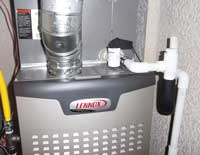
Photo 5: Trap on a blow-through system. Notice the tee fitting between the trap (wrapped in black insulation) and coil is plugged. This allows it to be used as a clean-out, but keeps air from being blown out of the tee (negating the function of the trap) when the blower is on. [Image HVAC-Talk.com]
Without a trap filled with water, air can move in or out of the drain openings when the blower is operating. Air that is lost through the condensate drain in blow-through systems primarily is an efficiency issue and can be likened to drilling a ¾-inch hole in the ducts for each drain connection without a trap. As for draining condensate, the pressure on a blow-through system almost guarantees that the pan will drain, trapped or not [Photo 5].
Without a trap on a draw-through system, untreated air is drawn into the air handler while the system is running. If the coil is located in an attic or other untreated air space, untreated air is often pulled inside the air handler and passed through the ducts with the treated air. As with a blow-through system, this is an efficiency issue, but more importantly, the air being sucked through the drainpipe can prevent the condensate tray from draining, causing it to run over. As the air is sucked through the opening, it can sometimes cause the water in the condensate tray to lift up and be splashed or sprayed from the tray. This is referred to as “geysering” and it can wet the insulation in the air handler and sometimes cause condensate to move into the ducts.
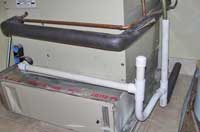
Photo 6: Trap on a draw-through system. The
pipe between the coil and trap has a removable
cap installed. This allows it to be used as a clean-
out, but keeps air from being sucked in through the pipe (negating the function of the trap) when the
blower is on. The opened vent (in box), downstream
of the trap, will not interfere with system operation.
[Image HVAC-Talk.com]
When condensate drains are installed, a vent pipe or a clean-out fitting often is placed between the evaporator/indoor coil and the trap. A clean-out in this location is handy, but a vent is not needed here for condensate to drain. When this vent pipe is left open or the clean-out unplugged, it negates the value of the trap, as air can be blown from or pulled into the system through the opening. This is a common cause for an overflowing condensate drain with draw-through systems. My recommendation is to install a removable cap or plug in the open pipe. This eliminates the unneeded opening as a vent, but still allows it to be used as a clean-out if ever needed. An opened vent or clean-out pipe after the trap is usually not an issue of concern [Photo 6].
During session breaks, attendees sometimes ask me about questionable flue
termination clearances they observe during their home inspections. I point out that charts and guides are available from manufacturers and code authorities regarding the venting of direct-vent and non-direct-vent furnaces. These guidelines define the clearances required between the vent terminals and air supply inlets to doors and windows that can be opened, air supply openings to buildings and the mechanical and non-mechanical combustion air inlets of other appliances. Some inspectors have told me that they refer to this information during an inspection. It seems that some new inspectors apparently see the words “direct-vent” somewhere on the furnace and assume that the direct-vent rules always apply to that furnace.
Condensing furnaces often can be installed as a single-pipe, non-direct-vent furnace or a two-pipe, direct-vent furnace. When installed as a direct-vent furnace, two plastic-(usually PVC) sealed vent pipes extend from the furnace to the exterior of the house. One provides outside combustion air to the burner and the other carries away the spent fuel exhaust. A direct-vent installation can reduce air infiltration into the structure and is more likely to ensure that cleaner combustion air will be delivered to the burner. The direct-vent method also helps provide better control of the humidity level within the house and, during operation, the furnace is quieter.
With a single-pipe installation, the combustion air intake pipe is eliminated and the combustion air is drawn from the space around the furnace. The combustion air could be pulled from inside the living area of the house, the basement or even the attic. If the installer determines that the intake air is acceptable for the job and eliminates the intake pipe, the furnace is considered a single-pipe, non-direct-vent installation. The primary benefit of installing the furnace this way is that it reduces installation costs.
When I set up my HVAC exhibits for training, I sometimes hear inspectors wonder out loud or ask other inspectors, “When did they start putting the A/C evaporator in the furnace?” I know immediately they are looking inside the condensing furnace. A 90%+ furnace (also known as a condensing furnace) has two heat exchangers. Less efficient furnaces only have one. The second heat exchanger in many condensing furnaces looks very much like a flat evaporator coil. In my condensing furnace exhibit, this is very much the case, as they both have tubing routed through a block of fins [Photo 7].
With modern condensing furnaces, when air is moved across the primary heat exchanger of a furnace, the sensible heat from the spent fuel moves to the airflow that passes to the house. With a condensing furnace, the spent fuel is cooled even more, to the point that water is squeezed from the exhaust gas. When a change of state takes place this way, latent heat is released along with the sensible heat. To cool the spent fuel gas to this point, a secondary, more restrictive heat exchanger is used. The secondary heat exchanger is what inspectors are seeing. The evaporator has not been placed inside the furnace. It should be located outside of the furnace and downstream of the heat exchanger.
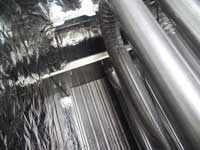
The modern furnaces that home inspectors see in the field have many clearance numbers stamped or printed somewhere on the cabinet. Back, top and side clearances to combustibles are easy to get. But with air conditioning condensing units and heat pump outdoor units, the clearance numbers can be hard to find without consulting the installation manual. When presenting my slideshows, I often cite —directly from the manuals — some of the most important numbers. I usually pull up these slides near the end of the presentation, but I am almost always asked for one or more of these clearance numbers before I get there.
To wrap up my Top 10, I thought I would post a few of these numbers here.
For top discharge (updraft) equipment, the following are recommended clearances:
- From walls, privacy fences and similar obstructions, requirements range from
6 to 10 inches - Between units, 18 to 24 inches
- From overhead obstructions that can block airflow, 48 to 60 inches
- For service access, 24 to 30 inches
You should always check out any
questions with the AHJ. And for the
exact clearance requirements for a specific piece of equipment, the AHJ might just
be the manufacturer.
In the August issue of ASHI Reporter: Join us on the road with Kenny. He will showcase his ASHI (and American) Roadshow Experience.
To Read the Full Article
ASHI offers its members unparalleled resources to advance their careers. ASHI offers training for inspectors at all levels of knowledge and experience, including resources about all major home systems. Members benefit from a vast network of experienced professionals, providing a community for mentorship and knowledge sharing..
In this Issue

FIND A HOME
INSPECTOR
Professional Networking
Grow your professional network, find a mentor, network with the best, and best part of the community that’s making home inspection better every day.
